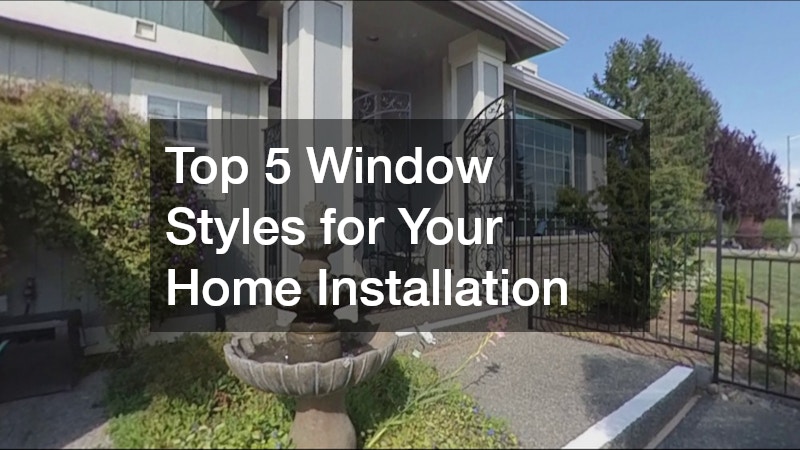Selecting the right window style is a vital part of any home improvement or renovation project. Not only do windows influence a property’s aesthetic, but they also affect functionality, energy efficiency and overall comfort. When planning a window installation, homeowners must consider a range of factors, including architectural style, ventilation needs and natural light preferences. The variety of window styles available today means there is something to suit every home, whether you’re designing a contemporary build or refreshing a traditional space.
Below, we explore five of the most popular window styles and how they can enhance your home.
Casement Windows: A Classic, Practical Choice
Casement windows are hinged at the side and open outward, much like a door. Their simplicity and versatility make them a favourite across a wide range of home designs. These windows offer excellent ventilation, as the entire pane can swing open to allow a maximum flow of fresh air. They are often operated with a crank mechanism, which also makes them a good choice for hard-to-reach areas, such as over kitchen sinks or countertops.
From a design perspective, casement windows offer clean lines and unobstructed views, especially appealing for modern or minimalist homes. Additionally, they seal tightly when closed, making them one of the more energy-efficient window styles on the market. If you’re planning a window installation and want a balance between form and function, casement windows are a strong contender.
Sliding Windows: Sleek & Space-Saving
Sliding windows open horizontally along a track, making them ideal for spaces where outward-opening windows might not be practical. They are often chosen for areas with limited exterior clearance, such as patios, verandas, or walkways, as they do not protrude outward when opened.
The straightforward operation and low maintenance requirements make sliding windows a popular option for many homeowners. They typically have fewer moving parts than other window types, which reduces the likelihood of mechanical issues over time. Their expansive panes also invite abundant natural light into the home, which can enhance mood and reduce reliance on artificial lighting. When incorporated into your window installation plan, sliding windows deliver both aesthetic appeal and functional efficiency.
Double-Hung Windows: Traditional Charm with Modern Benefits
Double-hung windows have stood the test of time, offering a timeless look that suits everything from heritage homes to contemporary builds. This style features two sashes that can move up and down independently, giving homeowners greater control over airflow. You can open the top, bottom, or both sashes at once to create a comfortable cross-breeze in any room.
While traditionally associated with classic Australian architecture, modern versions of double-hung windows incorporate advanced materials and improved insulation technologies. Many are now fitted with tilt-in sashes, allowing for easy cleaning from inside the home. Their combination of vintage charm and modern convenience makes them a versatile option for your next window installation.
Louvre Windows: Ideal for Coastal & Tropical Living
Louvre windows are composed of horizontal slats that can be angled open or closed. This design makes them particularly effective in warm climates where airflow is essential. They are especially prevalent in coastal and tropical regions, where the need for natural ventilation and resistance to moisture is paramount.
These windows can be made from glass, timber, or aluminium, offering a range of aesthetic choices to suit your home’s design. When open, louvre windows allow for superior air circulation compared to other types, as the slats can be adjusted to capture breezes from any direction. If you’re considering a window installation in a humid or breezy location, louvre windows could be the perfect solution.
Awning Windows: Versatile & Weather-Resistant
Awning windows are hinged at the top and open outward from the bottom, creating an awning-like effect that gives them their name. This unique operation allows them to be left open even during light rain, providing ventilation without letting moisture into the home. As such, they are often used in bathrooms, laundries and kitchens, or in combination with fixed panes for added style.
Thanks to their weatherproof design, awning windows are a reliable choice in climates prone to rain and wind. Their compact size and flexibility also make them a good option for tight spaces. When included in a comprehensive window installation project, awning windows enhance airflow, protect against the elements and add a contemporary touch to your property.
Conclusion: Choose the Right Style for Long-Term Value
Each window style brings its own benefits to a home, from the classic appearance of double-hung windows to the sleek lines of sliding panels. When planning a window installation, it’s essential to consider how each style aligns with your specific needs—be it for ventilation, aesthetics, energy efficiency, or spatial constraints. Casement and awning windows offer excellent sealing properties, while louvre designs maximise airflow. Sliding and double-hung windows bring versatility and timeless charm to your living spaces.
A thoughtfully selected window style can significantly enhance the comfort and value of your home. Whether you’re building from scratch or upgrading your existing space, investing in the right window installation ensures lasting beauty, functionality and performance.

